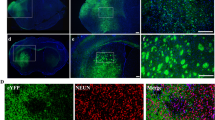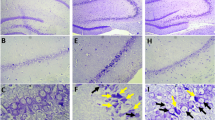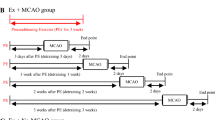Abstract
Identification of functional molecules in the brain related to improvement of motor dysfunction after stroke will contribute to establish a new treatment strategy for stroke rehabilitation. Hence, monoamine changes in basal ganglion related to motor control were examined in groups with/without voluntary exercise after cerebral infarction. Cerebral infarction was produced by photothrombosis in rats. Voluntary exercise using a running wheel was initiated from 2 days after surgery. Motor performance was measured by the accelerated rotarod test. Monoamine concentrations in striatum were analyzed using HPLC and immunohistochemical staining performed with anti-tyrosine hydroxylase antibody. In behavioral evaluation, the mean latency until falling from the rotating rod in the group with exercise (infarction-EX group) was significantly longer than that in the group without exercise (infarction-CNT group). When concerning the alteration of monoamine concentration between before and 2 days after infarction, dopamine level showed a significant increase 2 days after infarction. Subsequently, dopamine level was significantly decreased in the infarction-EX group at 10 days after infarction; in contrast, both norepinephrine and 5-HT concentrations were significantly higher in the infarction-EX group than in the infarction-CNT group. Furthermore, duration of rotarod test showed a significant inverse correlation with dopamine levels and a significant positive correlation with 5-HT levels. In immunohistochemical analysis, tyrosine hydroxylase immunoreactivity in substantia nigra pars compacta was shown to increase in the infarction-CNT group. In the present study, at least some of the alterations of monoamines associated with the improvement of paralysis in the basal ganglion related to motor control might have been detected.




Similar content being viewed by others
References
Nudo RJ, Wise BM, SiFuentes F, Milliken GW (1996) Neural substrates for the effects of rehabilitative training on motor recovery after ischemic infarct. Science 272:1791–1794
Johansson BB (2000) Brain plasticity and stroke rehabilitation. The Willis lecture. Stroke 31:223–230
Feydy A, Carlier R, Roby-Brami A, Bussel B, Cazalis F, Pierot L, Burnod Y, Maier MA (2002) Longitudinal study of motor recovery after stroke: recruitment and focusing of brain activation. Stroke 33:1610–1617
Biernaskie J, Corbett D (2001) Enriched rehabilitative training promotes improved forelimb motor function and enhanced dendritic growth after focal ischemic injury. J Neurosci 21:5272–5280
Brown CE, Wong C, Murphy TH (2008) Rapid morphologic plasticity of peri-infarct dendritic spines after focal ischemic stroke. Stroke 39:1286–1291
Takakusaki K, Habaguchi T, Ohtinata-Sugimoto J, Saitoh K, Sakamoto T (2003) Basal ganglia efferents to the brainstem centers controlling postural muscle tone and locomotion: a new concept for understanding motor disorders in basal ganglia dysfunction. Neuroscience 119:293–308
Alexander GE, Crutcher MD (1990) Functional architecture of basal ganglia circuits: neural substrates of parallel processing. Trends Neurosci 13:266–271
Watson BD, Dietrich WD, Busto R, Wachtel MS, Ginsberg MD (1985) Induction of reproducible brain infarction by photochemically initiated thrombosis. Ann Neurol 17:497–504
Paxinos G, Watson C (1998) The rat brain in stereotaxic coordinates. Academic Press, San Diego
Mizutani K, Sonoda S, Yamada K, Beppu H, Shimpo K (2011) Alteration of protein expression profile following voluntary exercise in the perilesional cortex of rats with focal cerebral infarction. Brain Res 1416:61–68
Nagatsu I, Inagaki S, Kondo Y, Karasawa N, Nagatsu T (1979) Immunofluorescent studies on the localization of tyrosine hydroxylase and dopamine-β-hydroxylase in the mes-, di-, and telencephalon of the rat using unperfused fresh frozen sections. Acta Histochem Cytochem 12:20–37
Vandeputte C, Taymans JM, Casteels C, Coun F, Ni Y, Van Laere K, Baekelandt V (2010) Automated quantitative gait analysis in animal models of movement disorders. BMC Neurosci 11:92
Schaar KL, Brenneman MM, Savitz SI (2010) Functional assessments in the rodent stroke model. Exp Transl Stroke Med 2:13–23
Winter B, Juckel G, Viktorov I, Katchanov J, Gietz A, Sohr R, Balkaya M, Hörtnagl H, Endres M (2005) Anxious and hyperactive phenotype following brief ischemic episodes in mice. Biol Psychiatry 57:1166–1175
Takagi N, Tsuru H, Yamamura M, Takeo S (1995) Changes in striatal dopamine metabolism after microsphere embolism in rats. Stroke 26:1101–1106
Leclere N, Andreeva N, Fuchs J, Kietzmann T, Gross J (2004) Hypoxia-induced long-term increase of dopamine and tyrosine hydroxylase mRNA levels. Prague Med Rep 105:291–300
Dishman RK, Berthoud HR, Booth FW, Cotman CW, Edgerton VR, Fleshner MR, Gandevia SC, Gomez-Pinilla F, Greenwood BN, Hillman CH, Kramer AF, Levin BE, Moran TH, Russo-Neustadt AA, Salamone JD, Van Hoomissen JD, Wade CE, York DA, Zigmond MJ (2006) Neurobiology of exercise. Obesity 14:345–356 (review)
Mattson MP, Maudsley S, Martin B (2004) BDNF and 5-HT: a dynamic duo in age-related neuronal plasticity and neurodegenerative disorders. Trends Neurosci 27:589–594
Chollet F, Tardy J, Albucher JF, Thalamas C, Berard E, Lamy C, Bejot Y, Deltour S, Jaillard A, Niclot P, Guillon B, Moulin T, Marque P, Pariente J, Arnaud C, Loubinoux I (2011) Fluoxetine for motor recovery after acute ischaemic stroke (FLAME): a randomised placebo-controlled trial. Lancet Neurol 10:123–130
Canales JJ, Capper-Loup C, Hu D, Choe ES, Upadhyay U, Graybiel AM (2002) Shifts in striatal responsivity evoked by chronic stimulation of dopamine and glutamate systems. Brain 125:2353–2363
Acknowledgments
This study was supported by a Grant-in-Aid for Young Scientists (B) from the Ministry of Education, Culture, Sports, Science and Technology of Japan [KAKENHI] No. 23700642.
Conflict of interest
The authors declare that they have no competing financial interests.
Author information
Authors and Affiliations
Corresponding author
Rights and permissions
About this article
Cite this article
Mizutani, K., Sonoda, S., Karasawa, N. et al. Effects of exercise after focal cerebral cortex infarction on basal ganglion. Neurol Sci 34, 861–867 (2013). https://doi.org/10.1007/s10072-012-1137-3
Received:
Accepted:
Published:
Issue Date:
DOI: https://doi.org/10.1007/s10072-012-1137-3




